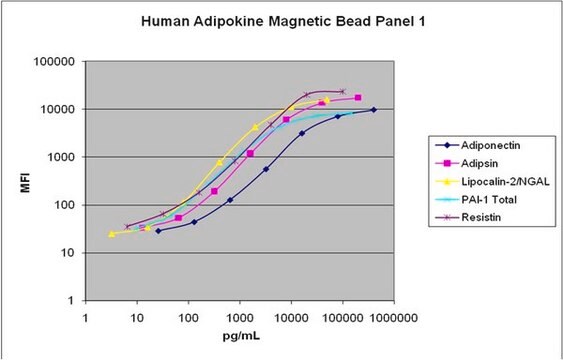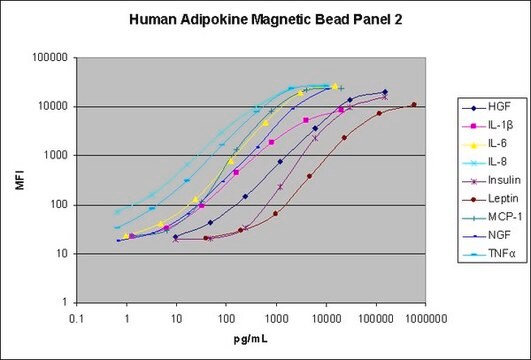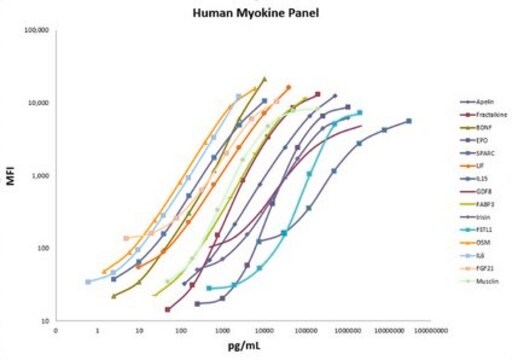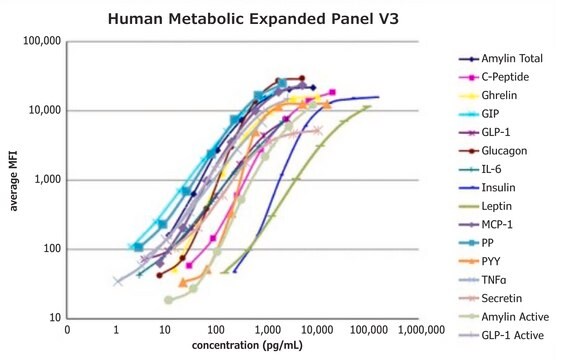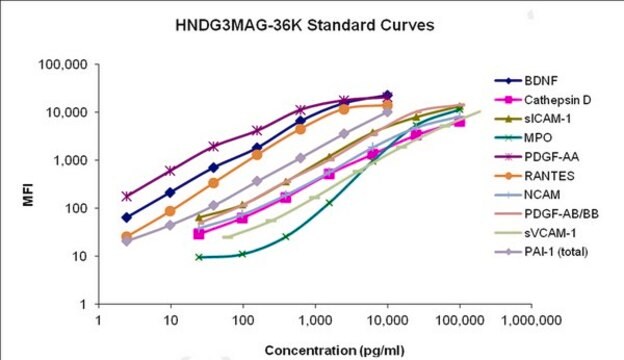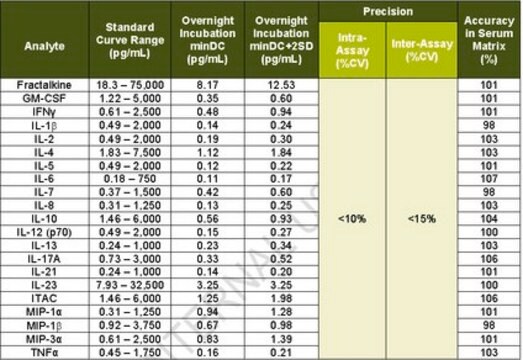HADCYMAG-61K
MILLIPLEX® Human Adipocyte Magnetic Bead Panel - Endocrine Multiplex Assay
The Human Adipocyte Magnetic Bead Panel, using the Luminex xMAP technology, enables the simultaneous analysis of 11 Adipocyte protein biomarkers in cell culture samples.
About This Item
Polecane produkty
Poziom jakości
reaktywność gatunkowa
human
producent / nazwa handlowa
Milliplex®
assay range
accuracy: 100%
(IL-6)
accuracy: 102%
(TNFα)
accuracy: 103%
(MCP-1)
accuracy: 83%
(PAI-1 (total))
accuracy: 99%
(HGF)
sensitivity: 0.2 pg/mL
(MinDC+2SD; IL-8)
sensitivity: 0.2 pg/mL
(MinDC+2SD; NGF)
sensitivity: 0.2 pg/mL
(MinDC+2SD; TNF?)
sensitivity: 0.6 pg/mL
(MinDC+2SD; IL-6)
sensitivity: 10 pg/mL
(MinDC+2SD; Leptin)
sensitivity: 15 pg/mL
(MinDC+2SD; Adiponectin)
sensitivity: 2.0 pg/mL
(MinDC+2SD; IL-1?)
sensitivity: 2.1 pg/mL
(MinDC+2SD; MCP-1)
sensitivity: 3.0 pg/mL
(MinDC+2SD; HGF)
sensitivity: 4.4 pg/mL
(MinDC+2SD; Resistin)
sensitivity: 4.6 pg/mL
(MinDC+2SD; PAI-1 (total))
standard curve range: 0.29-4,000 pg/mL
(IL-8)
standard curve range: 0.32-5,000 pg/mL
(NGF)
standard curve range: 0.38-6,000 pg/mL
(TNFα)
standard curve range: 0.51-8,000 pg/mL
(IL-1β)
standard curve range: 0.96-150,000 pg/mL
(IL-6)
standard curve range: 0.96-150,000 pg/mL
(MCP-1)
standard curve range: 26-400,000 pg/mL
(Adipnectin)
standard curve range: 6.4-100,000 pg/mL
(HGF)
standard curve range: 6.4-100,000 pg/mL
(Resistin)
standard curve range: 9.6-150,000 pg/mL
(Leptin)
standard curve range: 9.6-150,000 pg/mL
(PAI-1)
inter-assay cv: <15%
intra-assay cv: <10%
(Adiponectin)
inter-assay cv: <15%
intra-assay cv: <10%
(IL-8)
inter-assay cv: <15%
intra-assay cv: <10%
(MCP-1)
inter-assay cv: <15%
intra-assay cv: <10%
(Resistin)
inter-assay cv: <20%
intra-assay cv: <10%
(HGF)
inter-assay cv: <20%
intra-assay cv: <10%
(IL-6)
inter-assay cv: <20%
intra-assay cv: <10%
(NGF)
inter-assay cv: <20%
intra-assay cv: <10%
(PAI-1 (total))
inter-assay cv: <20%
intra-assay cv: <10%
(TNFα)
inter-assay cv: <20%
intra-assay cv: <15%
(IL-1β)
inter-assay cv: <25%
intra-assay cv: <20%
(Leptin)
metody
multiplexing: suitable
metoda wykrywania
fluorometric (Luminex xMAP)
Warunki transportu
wet ice
Powiązane kategorie
Opis ogólny
The MILLIPLEX® Human Adipocyte Panel is an 11-plex kit to be used for the simultaneous quantification of any or all of the following analytes in cell/tissue culture samples: Adiponectin, HGF, IL-β, IL-6, IL-8, Leptin, MCP-1, NGF, PAI-1 (total), Resistin, TNFα. This kit uses a 96-well format, contains a lyophilized standard cocktail, two internal assay quality controls and can measure up to 38 samples in duplicate.
The Luminex® xMAP® platform uses a magnetic bead immunoassay format for ideal speed and sensitivity to quantitate multiple analytes simultaneously, dramatically improving productivity while conserving valuable sample volume.
Panel Type: Metabolism
Specyficzność
There was no or negligible cross-reactivity between the antibodies for an analyte and any of the other analytes in this panel.
Zastosowanie
- Analytes: Adiponectin, HGF, IL-1β, IL-6, IL-8, Leptin, MCP-1, NGF, PAI-1 (Total), Resistin, TNF-α
- Recommended Sample Type: Tissue/cell culture supernatants or extracts
- Recommended Sample Dilution: 25 μL per well of undiluted tissue/cell culture sample; samples may require dilution with an appropriate medium prior to assay
- Assay Run Time: Overnight (16-18 hours) at 2-8°C
- Research Category: Metabolism
- Research Subcategory: Endocrine
Cechy i korzyści
Opakowanie
Przechowywanie i stabilność
Inne uwagi
Informacje prawne
Oświadczenie o zrzeczeniu się odpowiedzialności
Hasło ostrzegawcze
Danger
Zwroty wskazujące rodzaj zagrożenia
Zwroty wskazujące środki ostrożności
Klasyfikacja zagrożeń
Acute Tox. 3 Dermal - Acute Tox. 4 Inhalation - Acute Tox. 4 Oral - Aquatic Chronic 2 - Skin Sens. 1
Kod klasy składowania
6.1C - Combustible acute toxic Cat.3 / toxic compounds or compounds which causing chronic effects
Certyfikaty analizy (CoA)
Poszukaj Certyfikaty analizy (CoA), wpisując numer partii/serii produktów. Numery serii i partii można znaleźć na etykiecie produktu po słowach „seria” lub „partia”.
Masz już ten produkt?
Dokumenty związane z niedawno zakupionymi produktami zostały zamieszczone w Bibliotece dokumentów.
Powiązane treści
Wielokrotne testy immunologiczne oszczędzają czas i ilość próbek w badaniach nad zespołem metabolicznym, zapewniając kompleksowy wgląd w powiązane schorzenia.
Multiplex immunoassays, such as MILLIPLEX® multiplex metabolic assays, are critical in metabolic syndrome research because they provide a full picture of the different conditions related to it, like diabetes and obesity, as well as save time and sample volume.
Nasz zespół naukowców ma doświadczenie we wszystkich obszarach badań, w tym w naukach przyrodniczych, materiałoznawstwie, syntezie chemicznej, chromatografii, analityce i wielu innych dziedzinach.
Skontaktuj się z zespołem ds. pomocy technicznej